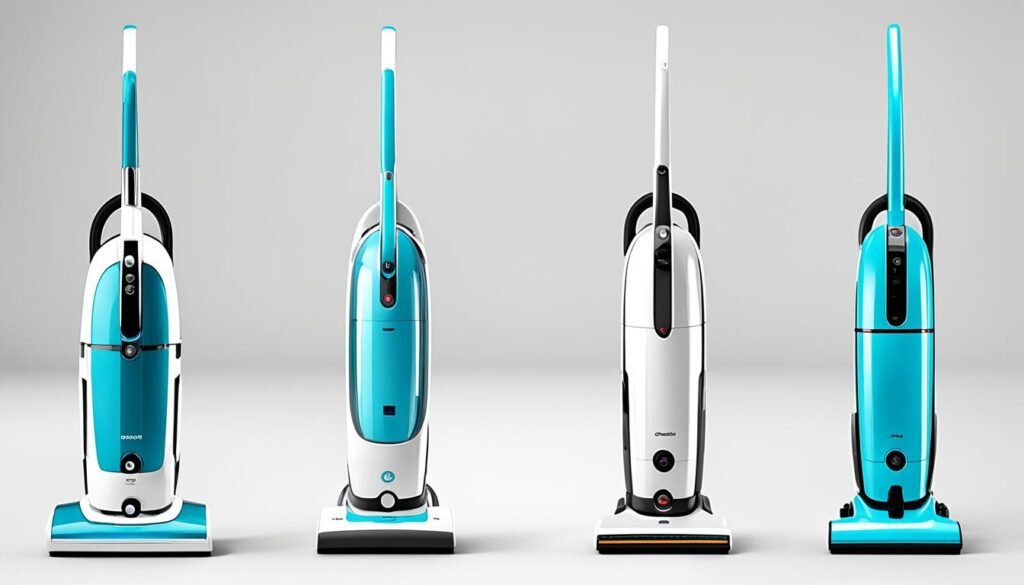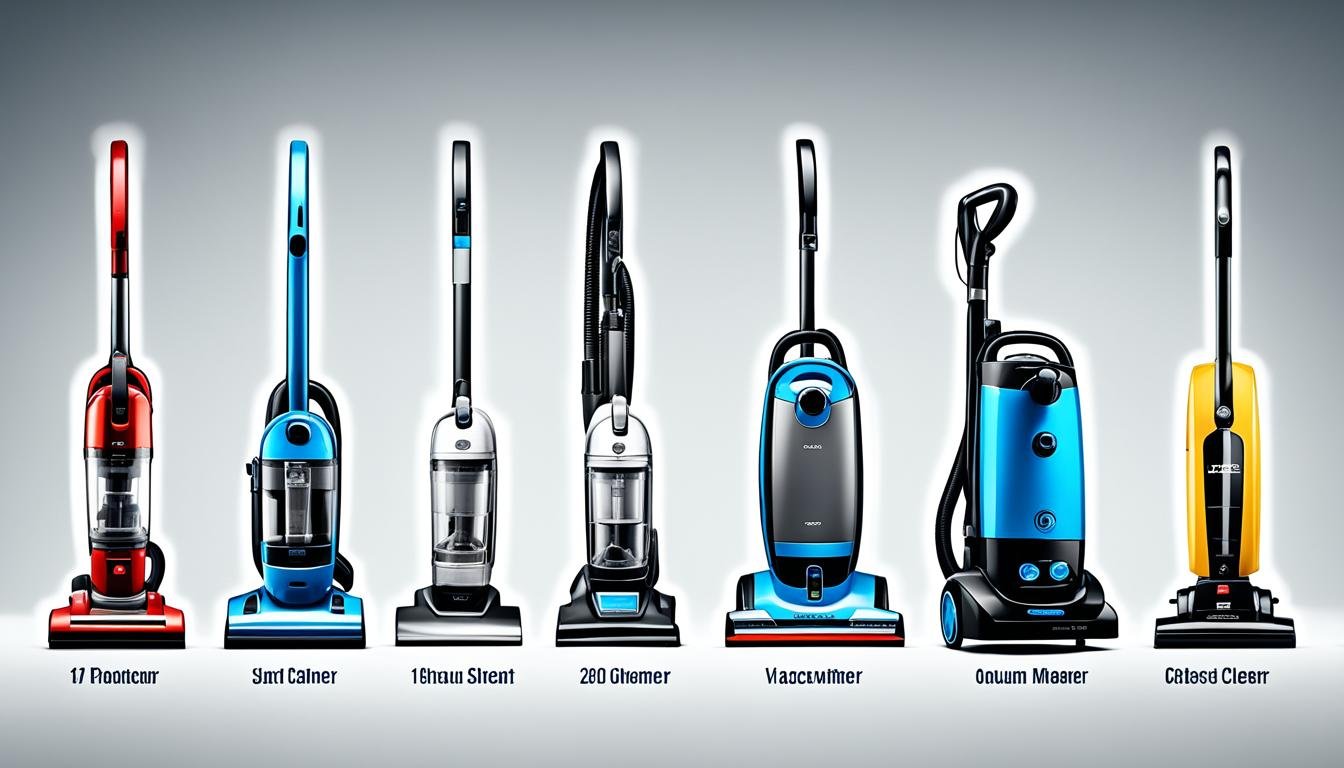Welcome to the fascinating world of vacuum cleaners! Have you ever wondered about the origins and evolution of this essential household appliance? In this article, I will take you on a journey through time to explore the history of vacuum cleaners and how they have evolved over the years.
The invention of the vacuum cleaner dates back to the 19th century. It all started with manual models called carpet sweepers, which were developed in the 1860s. These early devices used a rotating brush and bellows for suction, providing a rudimentary cleaning solution. However, it wasn’t until the early 20th century that motorized vacuum cleaners made their appearance.
In 1901, British engineer Hubert Cecil Booth revolutionized the industry by inventing the first vacuum cleaner that used suction instead of blowing air. This large machine had to be pulled by a horse and was primarily used as a cleaning service. Nevertheless, Booth’s invention laid the foundation for future advancements.
By 1915, smaller and more portable vacuum cleaners started to emerge. The introduction of electric appliances in the late 19th century played a crucial role in this development. As technology progressed, vacuum cleaners gradually became a household staple after the Second World War, making cleaning routines more efficient and convenient.
Key Takeaways:
- The history of vacuum cleaners dates back to the 19th century, with the invention of manual carpet sweepers.
- The first motorized vacuum cleaner, using suction, was invented in 1901 by Hubert Cecil Booth.
- Electric appliances in the late 19th century paved the way for the development of smaller, more portable vacuum cleaners.
- After the Second World War, vacuum cleaners became a common household item, improving cleaning practices.
- The evolution of vacuum cleaners showcases how innovation and technology have transformed our cleaning routines.
Now that we understand the origins and evolution of vacuum cleaners, let’s dive deeper into the fascinating advancements and technological breakthroughs that have shaped these essential cleaning appliances. Stay tuned for the next section!
The Evolution of Vacuum Cleaners
Over the years, vacuum cleaners have undergone various developments and technological advancements. These advancements have revolutionized the way we clean our homes and have made vacuum cleaners an indispensable part of our daily lives.
“The invention of the vacuum cleaner changed the way we approach cleaning tasks. It made cleaning more efficient and convenient, saving us time and effort.” – James B. Kirby, Inventor of the Domestic Cyclone
It all began in 1905 when Walter Griffiths designed the first portable vacuum cleaner. This innovative design utilized bellows for suction, allowing for more effective cleaning. The introduction of this portable vacuum cleaner marked a significant milestone in the development of these cleaning devices.
Building upon Griffiths’ invention, James B. Kirby introduced the world to the first motorized vacuum cleaner in 1906, known as the “Domestic Cyclone.” This groundbreaking invention incorporated a motor, providing increased power and suction capabilities.
A year later, in 1907, James Murray Spangler, a janitor, invented a portable electric vacuum cleaner. This invention would later play a pivotal role in the vacuum cleaner’s evolution. Spangler’s design included several innovations, such as a brush and a fan operated by an electric motor, as well as a pillowcase to capture dust and debris. Recognizing the potential of this invention, Spangler sold the patent to William Henry Hoover, who further refined and popularized the vacuum cleaner.
Under the Hoover brand, the vacuum cleaner underwent significant improvements. Hoover introduced notable features such as disposal filter bags, allowing for easy dust disposal, and the invention of the first upright vacuum cleaner, providing users with a more efficient and ergonomic cleaning experience.
The Technological Advancements in Vacuum Cleaners
Technological advancements in vacuum cleaners have continued to enhance their performance and convenience. Today, vacuum cleaners come equipped with powerful motors, advanced filtration systems, and specialized attachments for different surfaces and cleaning tasks.
The development of bagless vacuum cleaners has been a major breakthrough in recent years. These models utilize cyclonic technology to maintain suction power and eliminate the need for disposable bags. Additionally, robotic vacuum cleaners have gained popularity, offering hands-free cleaning and intelligent navigation systems that adapt to different floor types and layouts.
Table: Evolution of Vacuum Cleaners
| Year | Key Milestone |
|---|---|
| 1905 | Walter Griffiths designs the first portable vacuum cleaner using bellows for suction. |
| 1906 | James B. Kirby introduces the first motorized vacuum cleaner, the “Domestic Cyclone.” |
| 1907 | James Murray Spangler invents a portable electric vacuum cleaner and sells the patent to William Henry Hoover. |
| 1908 | Hoover redesigns the vacuum cleaner, introducing features like disposal filter bags and the first upright vacuum cleaner. |

These remarkable advancements in vacuum cleaner technology demonstrate how far these cleaning devices have come since their humble beginnings. Today, vacuum cleaners continue to evolve, enhancing our cleaning routines and making our lives easier.
The Popularity of Vacuum Cleaners
Vacuum cleaners have come a long way from being a luxury item to becoming a household staple in everyday life. After the Second World War, vacuum cleaners started gaining popularity among the middle class as individuals and households sought to keep up with modern cleaning technology. With a shortage of domestic help during the war, vacuum cleaners became essential tools for maintaining cleanliness and hygiene.
As technology evolved, vacuum cleaners became smaller, more portable, and more affordable. This made them accessible to a wider range of people, further contributing to their popularity. Today, it is hard to imagine a household without a vacuum cleaner. It has become an indispensable device that aids in the task of keeping our homes clean and dust-free.
But what exactly makes vacuum cleaners so popular and vital? Firstly, vacuum cleaners simplify the process of cleaning by efficiently sucking up dirt and dust from various surfaces. They save time and effort compared to traditional methods such as sweeping or using a broom. Vacuum cleaners are also effective in removing allergens, pet hair, and debris that accumulate in carpets, rugs, and upholstery, contributing to a healthier living environment for individuals and families.
Furthermore, modern vacuum cleaners come with advanced features that enhance their usability and performance. These features include adjustable suction power, different floor settings for various surfaces, specialized attachments for tackling different cleaning tasks, and advanced filtration systems that capture even the tiniest particles.
Here is a comparison of some popular vacuum cleaner brands and their key features:
| Brand | Key Features |
|---|---|
| Dyson | Powerful suction, innovative cyclone technology, HEPA filtration, variety of attachments |
| Shark | DuoClean technology for effective cleaning on both carpets and hard floors, Lift-Away feature for versatility, Anti-Allergen Complete Seal technology |
| Miele | German-engineered quality, powerful cleaning performance, advanced filtration, durable construction |
With so many options available in the market, consumers can choose a vacuum cleaner that aligns with their specific needs and preferences. Whether it’s a cordless stick vacuum for quick and easy clean-ups or a robot vacuum for hands-free cleaning, there is a vacuum cleaner for every lifestyle and budget.
In conclusion, the popularity of vacuum cleaners can be attributed to their convenience, effectiveness, and continuous innovation. They have transitioned from being a luxury item to a must-have tool for households worldwide. As technology continues to advance, we can expect further improvements in vacuum cleaner design and functionality, making them even more indispensable in our everyday lives.

Conclusion
Vacuum cleaners have come a long way since their inception in the 19th century. From the humble manual carpet sweepers to the large, horse-pulled contraptions of the past, they have evolved into compact, powerful, and efficient devices that have become an indispensable part of our everyday lives.
The invention of the vacuum cleaner has revolutionized cleaning practices, making household chores significantly more convenient and manageable. With continuous advancements in technology, vacuum cleaners have become increasingly versatile, offering a wide range of models and functionalities to cater to different cleaning needs.
The history and evolution of vacuum cleaners highlight the remarkable progress made through innovation and human ingenuity. These remarkable inventions have greatly improved our lives, simplifying the task of keeping our homes clean and tidy. Today, vacuum cleaners have become an essential tool in maintaining cleanliness and hygiene, a must-have item in every household.
FAQ
How long have vacuum cleaners been around?
Vacuum cleaners have been around since the 19th century.
What is the history of vacuum cleaners?
The first manual models, known as carpet sweepers, were developed in the 1860s. The first motorized vacuum cleaner that used suction was invented in 1901 by Hubert Cecil Booth.
What are the origins of vacuum cleaners?
Vacuum cleaners originated from the need to make cleaning easier and more efficient. The invention of the first manual models paved the way for the development of motorized vacuum cleaners.
Can you provide a timeline of vacuum cleaners’ development?
Vacuum cleaners evolved from manual carpet sweepers in the 1860s to motorized machines in the early 20th century. They became more portable and affordable before 1915, and further advancements were made in the following years.
What were the key technological advancements in vacuum cleaners?
The key technological advancements in vacuum cleaners included the introduction of electric appliances in the late 19th century, the development of portable vacuum cleaners with bellows for suction, the invention of the first motorized vacuum cleaner, and improvements such as disposal filter bags and the first upright vacuum cleaner.
Why did vacuum cleaners become a household staple?
Vacuum cleaners became a household staple after the Second World War due to their convenience and the shortage of domestic help. They gradually became more common among the middle class as they became smaller, more portable, and more affordable.
How are vacuum cleaners used in everyday life?
Vacuum cleaners are used in everyday life for maintaining cleanliness and hygiene in homes. They are essential tools for removing dust, dirt, and allergens from floors, carpets, and upholstery.





Leave a Reply